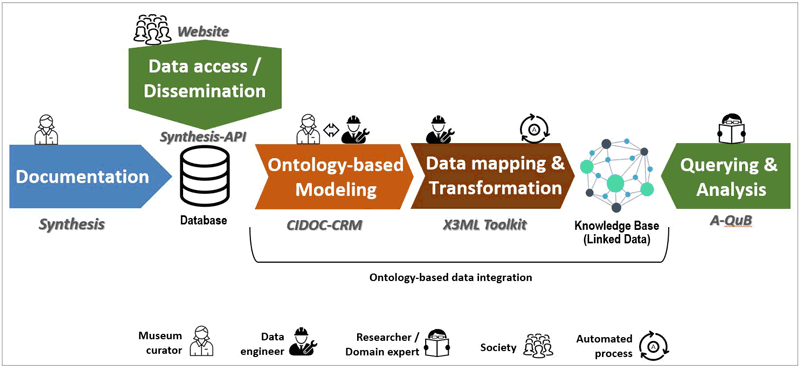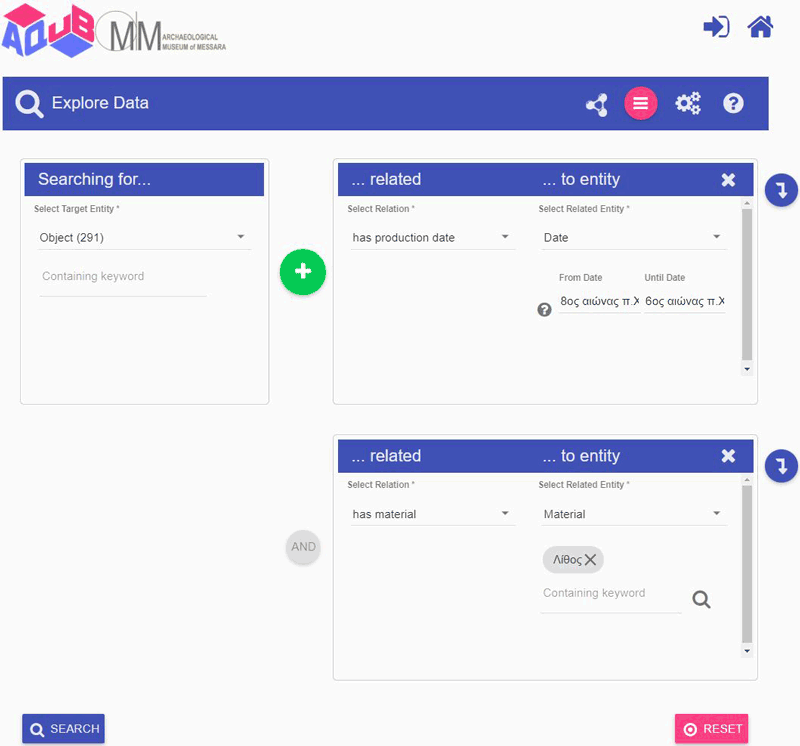by Dimitris Angelakis, Lida Charami, Pavlos Fafalios and Christos Georgis (FORTH-ICS)
The new Archaeological Museum of Messara, which opened its doors to visitors on 22 April 2023, is entirely dedicated to the antiquities of the Messara region in Heraklion, Greece. The Centre for Cultural Informatics of FORTH-ICS has undertaken the task to provide a comprehensive data management solution for the scientific and administrative documentation, research and promotion of the new museum’s important assets.
The Archaeological Museum of Messara [L1] is located around 50 kilometres south of the Heraklion city in the island of Crete in Greece. The museum is dedicated to the antiquities of the Messara area, aiming to highlight the unique character of this important region over time, from Prehistory to the Middle Ages. It includes around 900 square metres of exhibition halls, conservation workshops and an inner courtyard used for both exhibition and educational purposes. Its collection includes potteries, sculptures, figurines, metallic, clay and stone objects, inscriptions, seals, jewellery, glasses, frescoes, coins, bones, shells and organic material.
The museum’s data management needs include: a) the scientific documentation of the museum’s assets, which include not only objects but also monuments, archaeological sites, and early books/manuscripts; b) the management of the museum’s administrative material, such as the museum spaces, photographic documentations, condition assessments, and object conservations; and c) the management of presentation material required for dissemination and further data and knowledge exploitation, i.e. images, drawings, information texts, audio-visual material, etc.
The Data Management Workflow
To cope with these data management needs, the Centre for Cultural Informatics [L2] of FORTH-ICS has defined a workflow, accompanied by a set of IT tools, for the comprehensive management of the museum’s data: from documenting a set of cultural assets and disseminating them through the web, to integrating all data under a standard model and querying the integrated data for research and analysis purposes. The workflow, pictured in Figure 1, consists of the following main activities: i) scientific documentation, performed by the museum curators, ii) data access / dissemination, allowing the public to access the museum’s data, iii) ontology-based data modelling, for representing and integrating the data using a shared vocabulary in order to enable semantic interoperability and facilitate data reuse; iv) data mapping and transformation, for transforming the data to a rich semantic network of linked data that can be effectively queried; v) querying and analysis, performed by researchers and domain experts who study the cultural assets towards specific research objectives. Below we provide more information for each workflow component.

Figure 1: Workflow and IT tools for the holistic management of a museum's data.
Data Documentation with Synthesis
For the scientific documentation activity, we have configured appropriately the Synthesis system [L3]. Synthesis is an information system for the collaborative documentation of data and knowledge in the cultural heritage and humanities fields. It is highly configurable for use in specific domains and data management needs, supports the parallel use of multiple languages for documentation, allows the recording of provenance information at data-element level, and makes use of standards for data organisation and representation. It supports different user roles (administrator, editor, guest) and utilises XML technology and a multi-layer architecture, offering flexibility and extensibility in terms of data structures and data types. The system has been widely used in different contexts, including cultural heritage [1] and historical research [2,3].
Data Dissemination with the Messara Museum Website
The website of Messara Museum [L1] is used as the main dissemination channel of the museum’s data. The website reads the Synthesis data at real-time, which means that any change in the Synthesis database is directly reflected in the website. This is achieved through Synthesis-API, an application programming interface that provides a communication channel between the synthesis database and the website.
Data Integration with CIDOC CRM and the X3ML Toolkit
The objective here is to use a standard data model (a domain ontology) for modelling and representing the data as a rich semantic network of linked data (a knowledge graph). This process is important because it adds meaning to the data and increases their value, enables semantic interoperability (the ability of computer systems to exchange data with unambiguous, shared meaning), facilitates integration with similar external datasets that make use of the same data model, and supports advanced data querying, reasoning and inference making. In our case, we have used CIDOC CRM (Conceptual Reference Model) [L4] as the integration data model. CIDOC CRM is a high-level standard ontology (ISO 21127:2014) of human activity, things and events happening in space-time, providing a formal structure for describing concepts and relationships used in cultural heritage documentation. For transforming the Synthesis data to a CIDOC CRM compliant knowledge graph (in RDF format), we use the X3ML Toolkit [L5]. The toolkit offers a declarative language for defining data mappings (X3ML mapping definition language), a user interface for creating these mappings (3M Editor), software for executing the transformation and producing the semantic network (X3ML Engine), as well as a web application for visualising and validating the transformed data (RDF Visualizer).
Querying the integrated data with A-QuB-2
The CIDOC CRM-compliant knowledge graph can now be queried and analysed by researchers and domain experts. For this, we have deployed and configured appropriately the A-QuB-2 system [L6], a web application that facilitates the exploration of semantic (RDF) data by plain users. The application offers a user-friendly interface to build and execute complex queries step-by-step, while it also supports i) data filtering by text, date, number, Boolean value (true/false), and location (map area), ii) results browsing, iii) results export in CSV format for further offline data analysis, iv) query saving for future reuse. Figure 2 shows an example of query building in A-QuB-2 in which the user searches for all objects that have a) production date the period 8th-6th century BC, and b) stone as their construction material.

Figure 2: An example of query building in A-QuB-2.
This work has co-financed by Greece and the European Union within the Operational Program “CRETE” (ESPA 2014-2020).
Contributors: Chrysoula Bekiari, Theodosia Bitzou, Maria Chalkiadaki, Konstantina Konsolaki, Kostas Petrakis, Giorgos Samaritakis, Eleni Tsoulouha (FORTH-ICS).
Links:
[L1] https://messaramuseum.gr/
[L2] https://www.ics.forth.gr/isl/centre-cultural-informatics
[L3] https://www.ics.forth.gr/isl/synthesis-core
[L4] https://cidoc-crm.org/
[L5] https://www.ics.forth.gr/isl/x3ml-toolkit
[L6] https://github.com/isl/A-QuB-2
References:
[1] C. Bekiari et al., “Building Comprehensive Management Systems for Cultural-historical Information,” CAA, Archaeopress, Oxford, 2012.
[2] P. Fafalios et al., “Towards Semantic Interoperability in Historical Research: Documenting Research Data and Knowledge with Synthesis,” ISWC, Springer, 2021.
[3] P. Fafalios et al., “Documenting Data and Knowledge about Feminisms and Politics in the Interwar Balkans with Synthesis-Core,” ERCIM News, no. 133, 2023.
Please contact:
Pavlos Fafalios, Centre for Cultural Informatics, Institute of Computer Science, FORTH-ICS (Heraklion, Greece)











